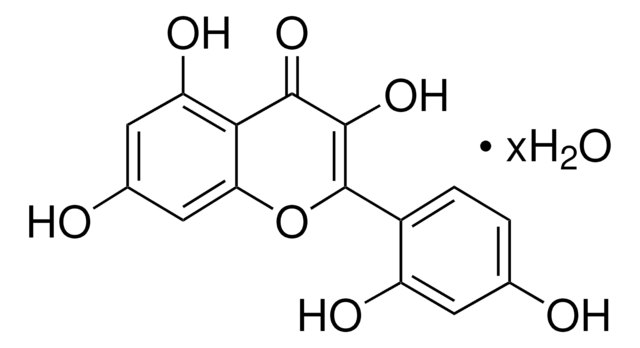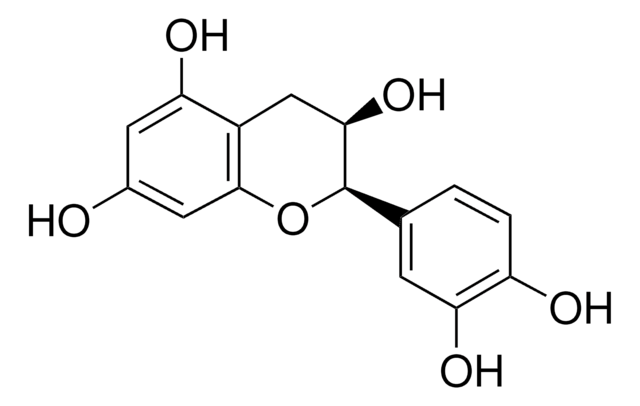T4512
(±)-Taxifolin hydrate
≥90% (HPLC)
Sinonimo/i:
3,3′,4′,5,7-Pentahydroxyflavanone hydrate, Dihydroquercetin hydrate
About This Item
Prodotti consigliati
Livello qualitativo
Saggio
≥90% (HPLC)
Forma fisica
powder
Solubilità
DMSO: 20 mg/mL
applicazioni
metabolomics
vitamins, nutraceuticals, and natural products
Temperatura di conservazione
−20°C
Stringa SMILE
O.O[C@@H]1[C@H](Oc2cc(O)cc(O)c2C1=O)c3ccc(O)c(O)c3
InChI
1S/C15H12O7.H2O/c16-7-4-10(19)12-11(5-7)22-15(14(21)13(12)20)6-1-2-8(17)9(18)3-6;/h1-5,14-19,21H;1H2/t14-,15+;/m0./s1
DNQPGSVMBPSRIR-LDXVYITESA-N
Informazioni sul gene
mouse ... Hexa(15211)
Cerchi prodotti simili? Visita Guida al confronto tra prodotti
Descrizione generale
Applicazioni
Azioni biochim/fisiol
Avvertenze
Warning
Indicazioni di pericolo
Consigli di prudenza
Classi di pericolo
Acute Tox. 4 Oral
Codice della classe di stoccaggio
11 - Combustible Solids
Classe di pericolosità dell'acqua (WGK)
WGK 3
Punto d’infiammabilità (°F)
Not applicable
Punto d’infiammabilità (°C)
Not applicable
Dispositivi di protezione individuale
dust mask type N95 (US), Eyeshields, Gloves
Certificati d'analisi (COA)
Cerca il Certificati d'analisi (COA) digitando il numero di lotto/batch corrispondente. I numeri di lotto o di batch sono stampati sull'etichetta dei prodotti dopo la parola ‘Lotto’ o ‘Batch’.
Possiedi già questo prodotto?
I documenti relativi ai prodotti acquistati recentemente sono disponibili nell’Archivio dei documenti.
I clienti hanno visto anche
Articoli
Information on fatty acid synthesis and metabolism in cancer cells. Learn how proliferatively active cells require fatty acids for functions such as membrane generation, protein modification, and bioenergetic requirements. These fatty acids are derived either from dietary sources or are synthesized by the cell.
Antioxidants protect biological systems from oxidative damage produced by oxygen-containing free radicals and from redoxactive transition metal ions such as iron, copper, and cadmium.
Il team dei nostri ricercatori vanta grande esperienza in tutte le aree della ricerca quali Life Science, scienza dei materiali, sintesi chimica, cromatografia, discipline analitiche, ecc..
Contatta l'Assistenza Tecnica.

